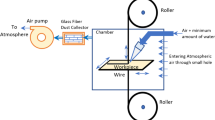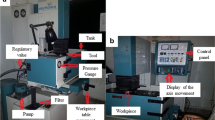Abstract
Green manufacturing is one of the most important development directions in mechanical processing field. Electrical discharge machining (EDM), one of the non-traditional machining, is increasingly used. However, there were hardly any studies on the evaluation of energy consumption and carbon emissions in EDM. In this study, a quantitative assessment model of carbon emission in EDM was built based on the emission factor method. The tool electrode wear, harmless treatment of residual tool electrodes and working fluid, and electrical energy consumed by the equipment were considered in this assessment model. EDM drilling experiments were conducted to verify the effectiveness of the proposed model. The effects of pulse width, pulse interval, and peak current on machining time, surface roughness, energy consumption, and carbon emissions were analyzed. The CNC system, cooling system, and power supply consumed about 95% of the total energy. In small hole EDM drilling, the total carbon emissions from the preparation and waste residue treatment of workpiece and tool electrode were almost negligible due to the small material removal volume. The carbon emissions generated by electrical energy consumption account for about 50% of the total carbon emissions. Carbon emissions can be minimized to 72 g and energy consumption can be reduced to a minimum of 37.48 Wh when processing a small hole with the diameter of 1 mm and the depth of 6 mm by EDM drilling.











Similar content being viewed by others
Data availability
All data generated or analyzed during this study are included within the article.
Code availability
Not applicable.
References
Li J, Cheng Z (2020) Study on total-factor carbon emission efficiency of China’s manufacturing industry when considering technology heterogeneity. J Clean Prod 260:121021. https://doi.org/10.1016/j.jclepro.2020.121021
Elbadawi M, Basit AW, Gaisford S (2023) Energy consumption and carbon footprint of 3D printing in pharmaceutical manufacture. Int J Pharm 639:122926–122926. https://doi.org/10.1016/j.ijpharm.2023.122926
Li Y, Mei Y, Zhang T, **e Y (2022) Paths to carbon neutrality in China’s chemical industry. Front Environ Sci10. https://doi.org/10.3389/fenvs.2022.999152
Abudureheman M, Jiang Q, Gong J, Yiming A (2023) Technology-driven smart manufacturing and its spatial impacts on carbon emissions: evidence from China. Comput Ind Eng 181:109283. https://doi.org/10.1016/j.cie.2023.109283
Liang S, Yang J, Ding T (2022) Performance evaluation of AI driven low carbon manufacturing industry in China: an interactive network DEA approach. Comput Ind Eng 170:108248. https://doi.org/10.1016/j.cie.2022.108248
Liu J, Yang Q, Ou S, Liu J (2022) Factor decomposition and the decoupling effect of carbon emissions in China’s manufacturing high-emission subsectors. Energy (Oxford) 248:123568. https://doi.org/10.1016/j.energy.2022.123568
Wang K, Yu L, Xu J, Zhang S, Qin J (2022) Energy consumption intelligent modeling and prediction for additive manufacturing via multisource fusion and inter-layer consistency. Comput Ind Eng 173:108720. https://doi.org/10.1016/j.cie.2022.108720
Ding H, Guo D, Cheng K, Cui Q (2014) An investigation on quantitative analysis of energy consumption and carbon footprint in the grinding process. Proceedings of the Institution of Mechanical Engineers. Part B, Journal of engineering manufacture 228:950–956. https://doi.org/10.1177/0954405413508280
Jiang Z, Gao D, Lu Y, Kong L, Shang Z (2019) Electrical energy consumption of CNC machine tools based on empirical modeling. Int J Adv Manuf Technol 100:2255–2267. https://doi.org/10.1007/s00170-018-2808-x
Jiang Z, Gao D, Lu Y, Liu X (2019) Optimization of Cutting Parameters for Trade-off Among Carbon Emissions, Surface Roughness, and Processing time. Chinese J Mech Eng 32:1–18. https://doi.org/10.1186/s10033-019-0408-9
Wójcicki J, Leonesio M, Bianchi G (2018) Integrated energy analysis of cutting process and spindle subsystem in a turning machine. J Clean Prod 170:1459–1472. https://doi.org/10.1016/j.jclepro.2017.09.234
Liu X, Liu Z, Lin C, Bai B (2014) Carbon Emission Modeling and Analysis in Manufacturing Process for Numerical Control Machine Tools. Dong Hua da xue xue bao. Zi ran ke xue ban 31:827–830. https://api.semanticscholar.org/CorpusID:107186134. Accessed 19 Sep 2023
Zhou G, Zhang C, Lu F, Zhang J (2020) Integrated optimization of cutting parameters and tool path for cavity milling considering carbon emissions. J Clean Prod 250:119454. https://doi.org/10.1016/j.jclepro.2019.119454
Kashyap N, Rahman Rashid RA, Khanna N (2022) Carbon emissions, techno-economic and machinability assessments to achieve sustainability in drilling Ti6Al4V ELI for medical industry applications. Sustain Mater Technol 33:e00458. https://doi.org/10.1016/j.susmat.2022.e00458
Zahiruddin M, Kunieda M (2012) Comparison of energy and removal efficiencies between micro and macro EDM. CIRP Ann Manuf Technol 61:187–190. https://doi.org/10.1016/j.cirp.2012.03.006
Ming W, Zhang Z, Wang S, Zhang Y, Shen F, Zhang G (2019) Comparative study of energy efficiency and environmental impact in magnetic field assisted and conventional electrical discharge machining. J Clean Prod 214:12–28. https://doi.org/10.1016/j.jclepro.2018.12.231
Zheng J, Lai X, Zhou X, Chen A, Zheng W (2019) Non-pulsed Energy Modeling Based on Energy Consumption Subunits in Wire Electrical Discharge Machining (WEDM) Process. Int J Precis Eng Manuf 20:853–862. https://doi.org/10.1007/s12541-019-00107-y
Yang M, Zhang D, Wu B, Zhang Y (2020) Energy consumption modeling for EDM based on material removal rate. IEEE access 8:173267–173275. https://doi.org/10.1109/ACCESS.2020.3024748
Zheng J, Lai X, Chen A, Zheng W (2019) Energy modeling and minimizing energy consumption control strategy of wire electrical discharge machining (WEDM) through electrical parameters. Int J Adv Manuf Technol 103:4341–4353. https://doi.org/10.1007/s00170-019-03771-6
Jiang K, Wu X, Lei J et al (2021) Investigation on the geometric evolution of microstructures in EDM with a composite laminated electrode. J Clean Prod 298:126765. https://doi.org/10.1016/j.jclepro.2021.126765
Tang L, Du YT (2014) Experimental study on green electrical discharge machining in tap water of Ti–6Al–4V and parameters optimization. Int J Adv Manuf Technol 70:469–475. https://doi.org/10.1007/s00170-013-5274-5
Ravasio C, Pellegrini G, Quarto M (2023) Development of CO2 efficiency index for evaluating sustainability of micro electrical discharge drilling process. Proceedings of the Institution of Mechanical Engineers. Part B, Journal of engineering manufacture 237:758–769. https://doi.org/10.1177/09544054221111903
Zheng J, Ren Y, Yao J et al (2022) Energy and CO2 emissions modeling for unconventional machining industry considering processing characteristics. Sci Total Environ 816:151542–151542. https://doi.org/10.1016/j.scitotenv.2021.151542
Zheng J, Huang B, Zhou X (2018) A low carbon process design method of sand casting based on process design parameters. J Clean Prod 197:1408–1422. https://doi.org/10.1016/j.jclepro.2018.06.285
Funding
The authors appreciate the support from the National Natural Science Foundation of China (No.52005298), Young Scholars Program of Shandong University, Weihai, (No.202209), the Natural Science Foundation of Shandong Province (No. ZR2021ME048), and Innovation Ability Enhancement Project of Small and Medium-sized Enterprises of Shandong Province (No.2023TSGC0305). This work was also supported by the Physical–Chemical Materials Analytical & Testing Center of Shandong University at Weihai.
Author information
Authors and Affiliations
Contributions
Jiuyong Xu performed the experiment, the data analyses, and wrote the manuscript; Kan Wang contributed to the conception of the study and edited the manuscript; others helped perform the analysis with constructive discussions.
Corresponding author
Ethics declarations
Ethics approval
Compliance with ethical standards.
Consent to participate
All authors agreed with the consent to participate.
Consent for publication
All authors have read and agreed to the publication of the paper.
Competing interests
The authors declare no competing interests.
Additional information
Publisher's Note
Springer Nature remains neutral with regard to jurisdictional claims in published maps and institutional affiliations.
Rights and permissions
Springer Nature or its licensor (e.g. a society or other partner) holds exclusive rights to this article under a publishing agreement with the author(s) or other rightsholder(s); author self-archiving of the accepted manuscript version of this article is solely governed by the terms of such publishing agreement and applicable law.
About this article
Cite this article
Xu, J., Wang, K., Liu, Y. et al. Evaluation of energy consumption and carbon emission in EDM. Int J Adv Manuf Technol 132, 1511–1524 (2024). https://doi.org/10.1007/s00170-024-13469-z
Received:
Accepted:
Published:
Issue Date:
DOI: https://doi.org/10.1007/s00170-024-13469-z




